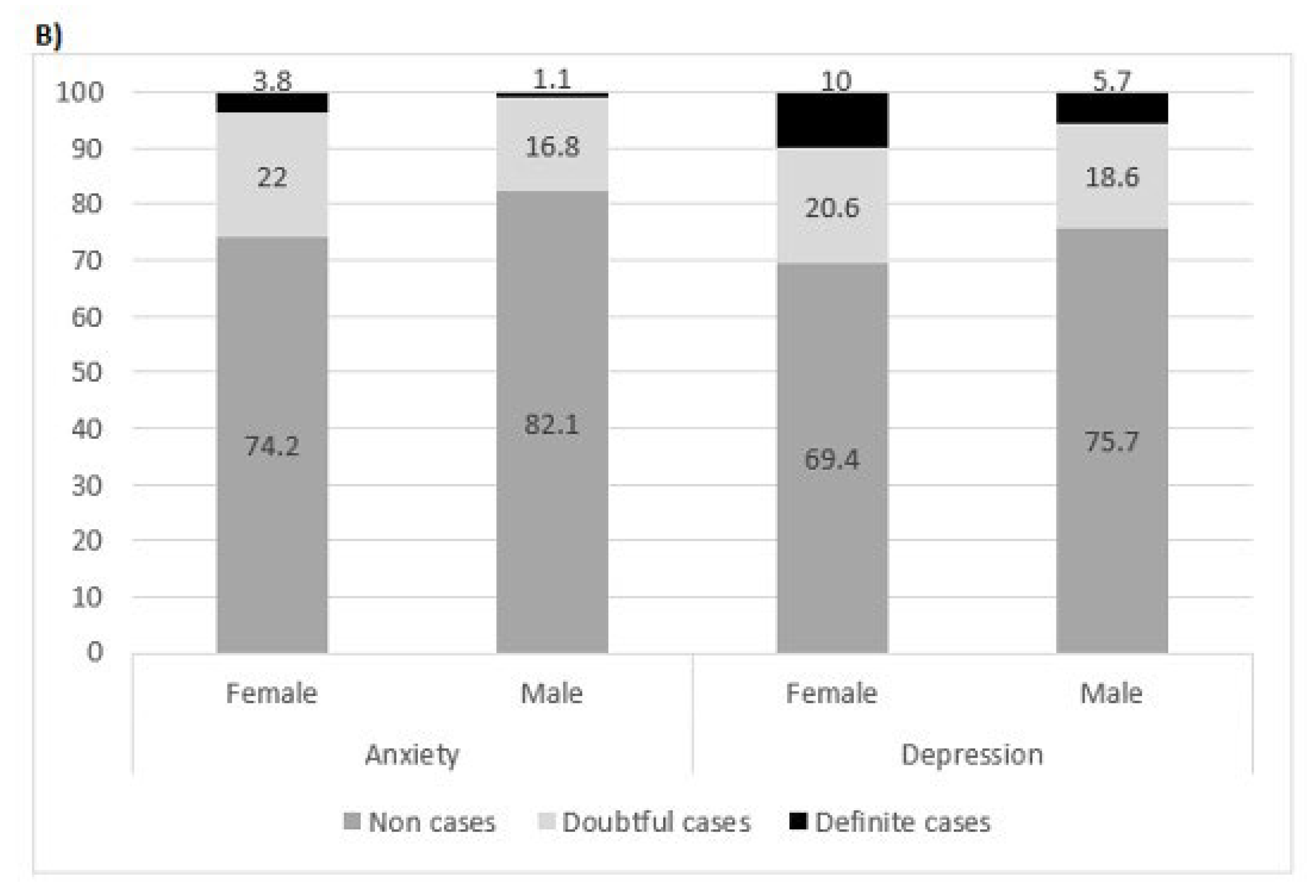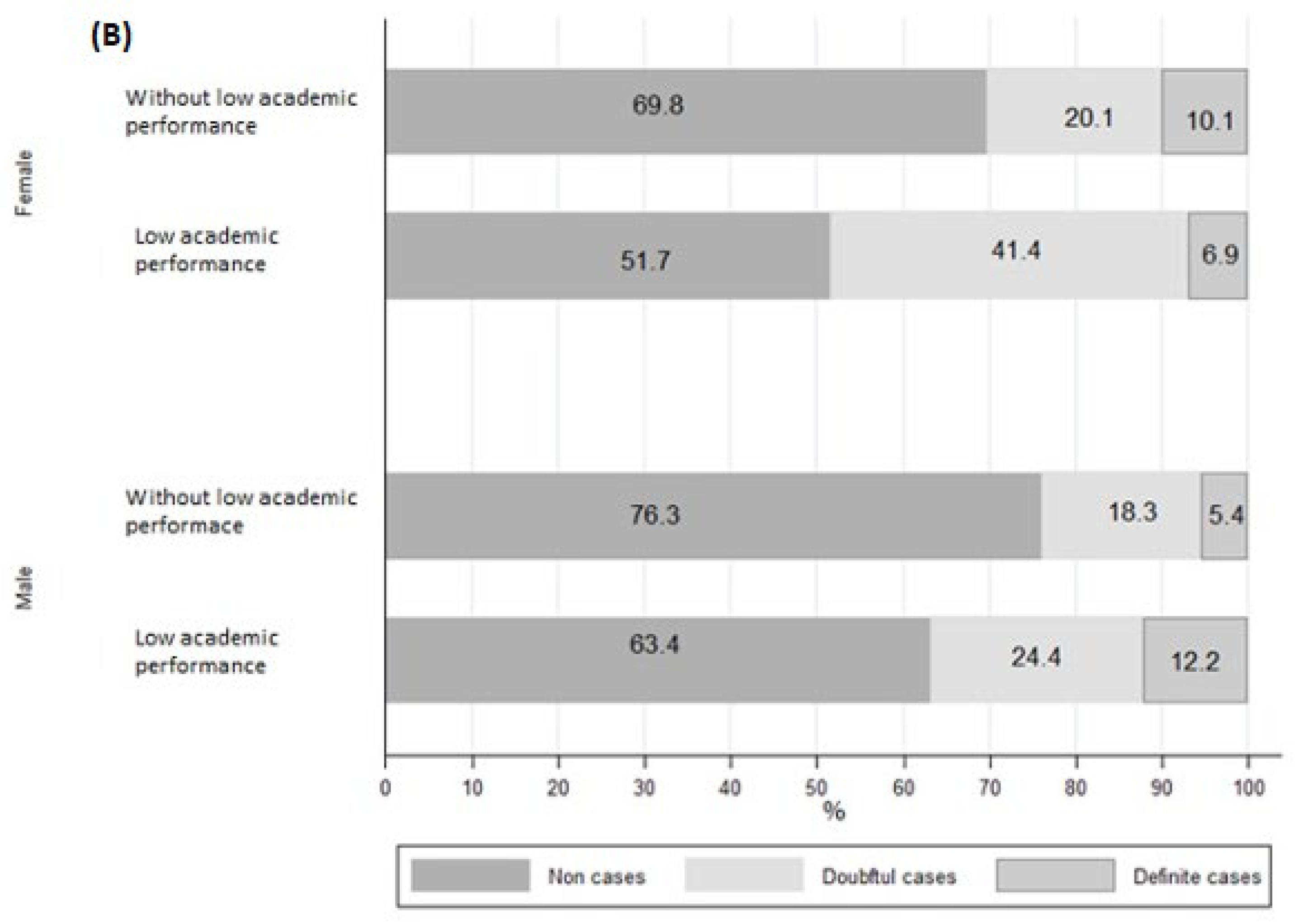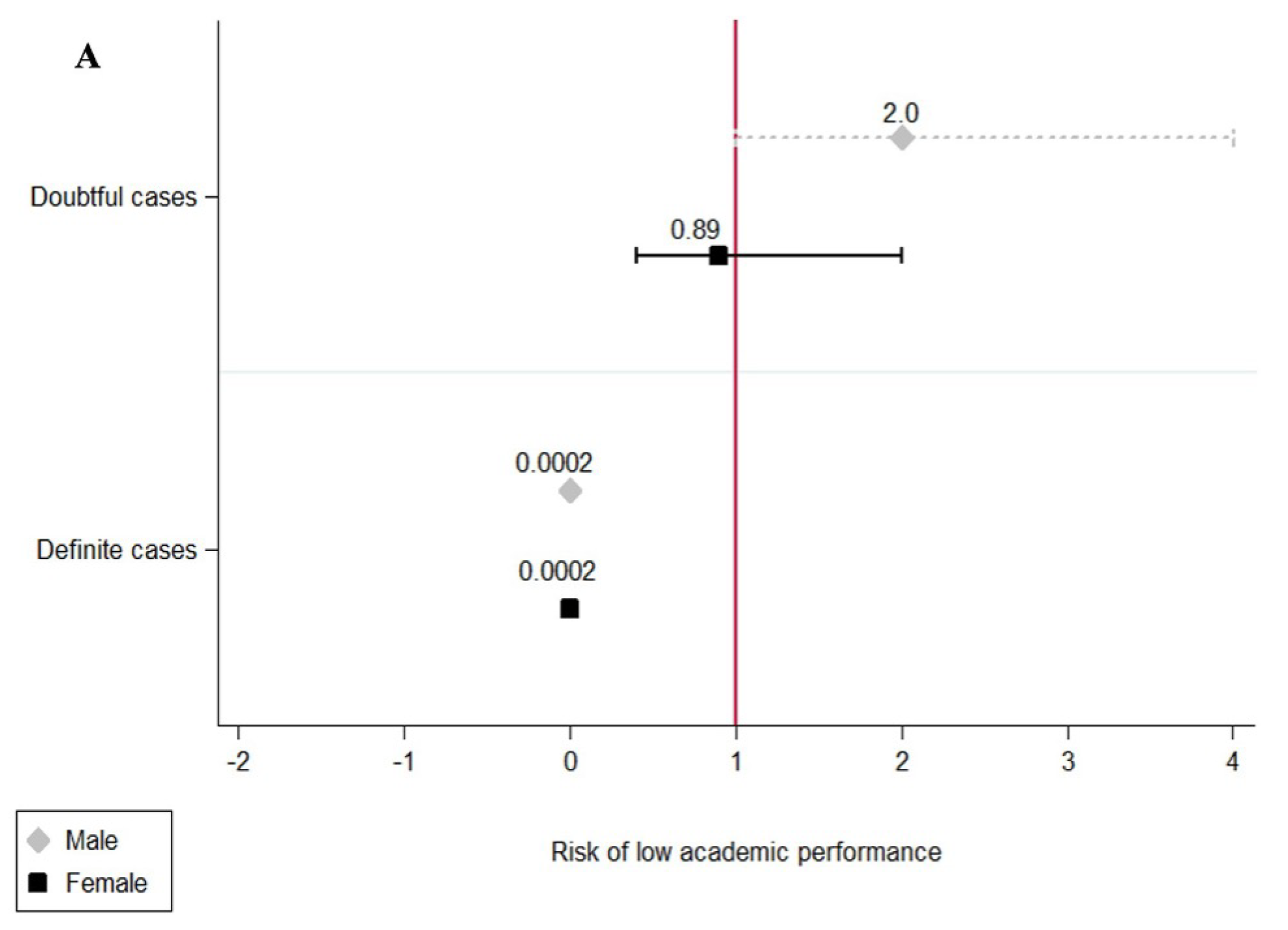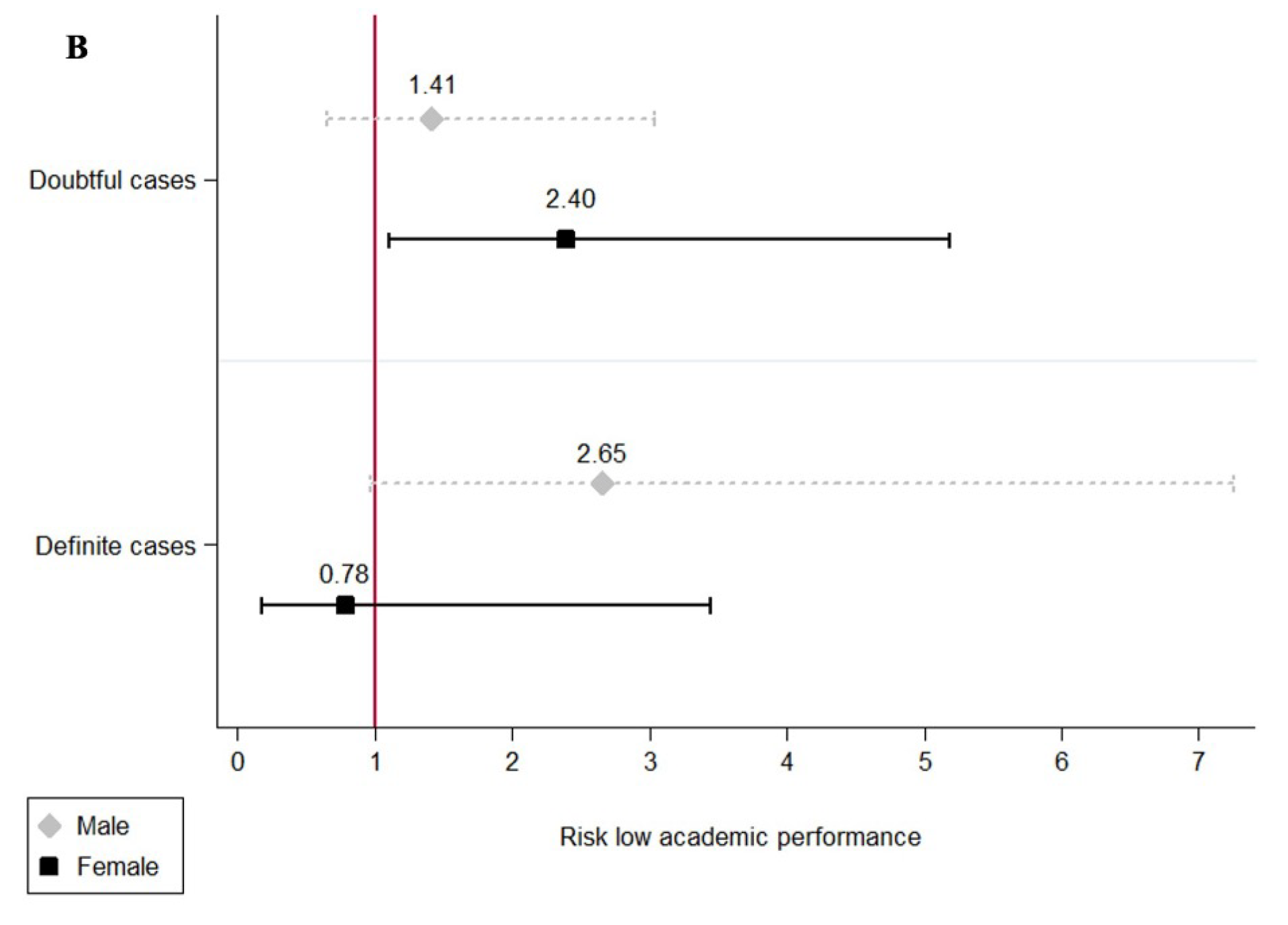Cross-Sectional Analysis of Colombian University Students’ Perceptions of Mental Health during the COVID-19 Pandemic: Repercussions on Academic Achievement
Abstract
1. Introduction
2. Materials and Methods
2.1. Study Design
2.2. Procedure
2.3. Mental Health Variables
2.4. Grade Point Averages
2.5. Covariables
2.6. Statistical Analysis
3. Results
3.1. Characteristics of the Participants
3.2. Mental Health Findings
3.3. Frequency of Low Academic Performance according to Sociodemographic Variables
3.4. Association between Academic Performance and Mental Health Findings
4. Discussion
4.1. Academic Performance and Lockdown
4.2. Mental Health Psychological and Lockdown
5. Limitations
6. Practical Applications
7. Conclusions
Author Contributions
Funding
Institutional Review Board Statement
Informed Consent Statement
Data Availability Statement
Acknowledgments
Conflicts of Interest
References
- Johns Hopkins University & Medicine of COVID-19 Map. Available online: https://coronavirus.jhu.edu/map.html (accessed on 15 February 2022).
- Siglo, E. Nuevo Aumentan Casos Covid En Colombia a 626, Bogotá Registra 255. Available online: https://www.elnuevosiglo.com.co/articulos/05-04-2023-aumentan-casos-covid-en-colombia-626-bogota-registra-255 (accessed on 1 May 2023).
- González, N.; Tejeda, A.; Espinosa, C.; Ontiveros, Z. Impacto Psicológico En Estudiantes Universitarios Mexicanos Por Confinamiento Durante La Pandemia Por COVID-19. Scielo Prepr. 2020, 46, 1–17. [Google Scholar] [CrossRef]
- Monterrosa, A.; Ojeda, A.; Arc, C.; Gómez, J.; De la Rosa, A. Impact of COVID-19 Lockdown on Physical Activity and Psychological Well-Being in Taekwondo Athletes. Ido Mov. Cult. J. Martial Arts Antrhropol. 2023, 23, 71–83. [Google Scholar] [CrossRef]
- Realyvásquez, A.; Maldonado, A.; Arredondo, K.; Baez, Y.; Carrillo, T.; Hernández, G. The Impact of Environmental Factors on Academic Performance of University Students Taking Online Classes during the COVID-19 Pandemic in Mexico. Sustainability 2020, 12, 9194. [Google Scholar] [CrossRef]
- Cao, W.; Fang, Z.; Hou, G.; Han, M.; Xu, X.; Dong, J.; Zheng, J. The Psychological Impact of the COVID-19 Epidemic on College Students in China. Psychiatry Res. 2020, 287, 112934. [Google Scholar] [CrossRef]
- Hawes, M.; Szenczy, A.; Klein, D.; Hajcak, G.; Nelson, B. Increases in Depression and Anxiety Symptoms in Adolescents and Young Adults during the COVID-19 Pandemic. Psychol. Med. 2022, 52, 3222–3230. [Google Scholar] [CrossRef]
- Liyanage, S.; Saqib, K.; Khan, A.F.; Thobani, T.R.; Tang, W.C.; Chiarot, C.; Alshurman, B.A.; Butt, Z.A. Prevalence of Anxiety in University Students during the Covid-19 Pandemic: A Systematic Review. Int. J. Environ. Res. Public Health 2022, 19, 62. [Google Scholar] [CrossRef]
- Wang, C.; Zhao, H. The Impact of COVID-19 on Anxiety in Chinese University Students. Front. Psychol. 2020, 11, 1168. [Google Scholar] [CrossRef]
- Khoshaim, H.B.; Al-Sukayt, A.; Chinna, K.; Nurunnabi, M.; Sundarasen, S.; Kamaludin, K.; Baloch, G.M.; Hossain, S.F.A. Anxiety Level of University Students During COVID-19 in Saudi Arabia. Front. Psychiatry 2020, 11, 579750. [Google Scholar] [CrossRef]
- Ettman, C.; Abdalla, S.; Cohen, G.; Sampson, L.; Vivier, P.; Galea, S. Prevalence of Depression Symptoms in US Adults before and during the COVID-19 Pandemic. JAMA Netw. Open 2020, 3, e2019686. [Google Scholar] [CrossRef]
- Özdin, S.; Bayrak Özdin, Ş. Levels and Predictors of Anxiety, Depression and Health Anxiety during COVID-19 Pandemic in Turkish Society: The Importance of Gender. Int. J. Soc. Psychiatry 2020, 66, 504–511. [Google Scholar] [CrossRef]
- Wang, X.; Hegde, S.; Son, C.; Keller, B.; Smith, A.; Sasangohar, F. Investigating Mental Health of US College Students during the COVID-19 Pandemic: Cross-Sectional Survey Study. J. Med. Internet Res. 2020, 22, e22817. [Google Scholar] [CrossRef] [PubMed]
- Qin, B.; Hu, Z.; Liu, W.; Sun, Y.; Wang, Y.; Yang, F.; He, Y. Anxiety and Depression Among College Students During the COVID-19 Lockdown: A Cross-Sectional Survey in Jiangsu, China. Risk Manag. Healthc. Policy 2023, 16, 711–723. [Google Scholar] [CrossRef] [PubMed]
- Patrono, A.; Renzetti, S.; Manco, A.; Brunelli, P.; Moncada, S.; Macgowan, M.; Placidi, D.; Calza, S.; Cagna, G.; Rota, M.; et al. COVID-19 Aftermath: Exploring the Mental Health Emergency among Students at a Northern Italian University. Int. J. Environ. Res. Public Health 2022, 19, 8587. [Google Scholar] [CrossRef] [PubMed]
- De la Rosa, A.; Monterrosa Quintero, A.; Camacho-Villa, M.A.; Arc-Chagnaud, C.; Pereira de Andrade, A.G.; Reyes-Correa, S.; Quintero-Bernal, R.; Fuentes-García, J.P. Physical Activity Levels and Psychological Well-Being during COVID-19 Lockdown among University Students and Employees. Int. J. Environ. Res. Public Health 2022, 19, 11234. [Google Scholar] [CrossRef]
- Ozamiz-Etxebarria, N.; Dosil-Santamaria, M.; Picaza-Gorrochategui, M.; Idoiaga-Mondragon, N. Niveles de Estrés, Ansiedad y Depresión En La Primera Fase Del Brote Del COVID-19 En Una Muestra Recogida En El Norte de España. Cad. Saude Publica 2020, 36, e00054020. [Google Scholar] [CrossRef]
- Huang, Y.; Zhao, N. Generalized Anxiety Disorder, Depressive Symptoms and Sleep Quality during COVID-19 Outbreak in China: A Web-Based Cross-Sectional Survey. Psychiatry Res. 2020, 288, 112954. [Google Scholar] [CrossRef]
- Bacca, O.; Camacho, M.; Torres, I.; Sanchez-Martinez, Y. COVID-19 Pandemic: Regular Physical Activity and Respiratory Exercises at Home as Prevention and Treatment. Physiother. Q. 2022, 30, 104–106. [Google Scholar] [CrossRef]
- Rodríguez-Hidalgo, A.; Pantaleón, Y.; Dios, I.; Falla, D. Fear of COVID-19, Stress, and Anxiety in University Undergraduate Students: A Predictive Model for Depression. Front. Psychol. 2020, 11, 591797. [Google Scholar] [CrossRef]
- Co, M.; Ho, M.K.; Bharwani, A.A.; Yan Chan, V.H.; Yi Chan, E.H.; Poon, K.S. Cross-Sectional Case-Control Study on Medical Students’ Psychosocial Stress during COVID-19 Pandemic in Hong Kong. Heliyon 2021, 7, e08486. [Google Scholar] [CrossRef]
- AL-Husban, N.; Alkhayat, A.; Aljweesri, M.; Alharbi, R.; Aljazzaf, Z.; Al-Husban, N.; Elmuhtaseb, M.; Al Oweidat, K.; Obeidat, N. Effects of COVID-19 Pandemic on Medical Students in Jordanian Universities: A Multi-Center Cross-Sectional Study: Covid-19 Pandemic and Medical Students. Ann. Med. Surg. 2021, 67, 102466. [Google Scholar] [CrossRef]
- Meiyi, Z.; Liu, Y. Impact of Fear of COVID-19 on Students’ Performance, Moderating Role of Mindfulness: HSK Students’ Perception-Based View. Front. Public Health 2022, 10, 967125. [Google Scholar] [CrossRef] [PubMed]
- Gonzalez, T.; De la Rubia, M.; Hincz, K.; Comas-Lopez, M.; Subirats, L.; Fort, S.; Sacha, G. Influence of COVID-19 Confinement on Students’ Performance in Higher Education. PLoS ONE 2020, 15, e0239490. [Google Scholar] [CrossRef] [PubMed]
- Iglesias-Pradas, S.; Hernández-García, Á.; Chaparro-Peláez, J.; Prieto, J.L. Emergency Remote Teaching and Students’ Academic Performance in Higher Education during the COVID-19 Pandemic: A Case Study. Comput. Human Behav. 2021, 119, 106713. [Google Scholar] [CrossRef] [PubMed]
- Zigmond, A.; Snalth, R. The Hospital Anxiety and Depression Scale. Acta Psychiatry Scand. 1983, 67, 361–370. [Google Scholar] [CrossRef]
- Galindo, Ó.; Meneses, A.; Herrera, Á.; Caballero, M.; Aguilar, J. Escala Hospitalaria de Ansiedad y Depresión (HADS) En Cuidadores Primarios Informales de Pacientes Con Cáncer: Propiedades Psicométricas. REVESCO Rev. Estud. Coop. 2015, 121, 7–32. [Google Scholar]
- Cardona-arias, J.; Ospina-franco, L. Validez Discriminante, Convergente/Divergente, Fiabilidad y Consistencia Interna, Del Whoqol-Bref y El Mossf-36 En Adultos Sanos de Un Municipio Colombiano. Rev. Fac. Nac. Salud Pública 2015, 33, 50–57. [Google Scholar]
- Nogueda, M.; Pérez, B.; Barrientos, V.; Robles, R.; Sierra, J. Escala de Ansiedad y Depresión Hospitalaria (HADS): Validación En Pacientes Mexicanos Con Infección Por Vih. Psicol. Iberoam. 2013, 21, 29–37. [Google Scholar] [CrossRef]
- Greenland, S. Modeling and Variable Selection in Epidemiologic Analysis. Am. J. Public Health 1989, 79, 340–349. [Google Scholar] [CrossRef]
- Chowdhury, M.; Turin, T. Variable Selection Strategies and Its Importance in Clinical Prediction Modelling. Fam. Med. Community Health 2020, 8, e000262. [Google Scholar] [CrossRef]
- Surfshark. Available online: https://surfshark.com/dql2020 (accessed on 1 May 2023).
- Jojoa, M.; Garcia-Zapirain, B.; Gonzalez, M.; Perez-Villa, B.; Urizar, E.; Ponce, S.; Tobar, M. Analysis of the Effects of Lockdown on Staff and Students at Universities in Spain and Colombia Using Natural Language Processing Techniques. Int. J. Environ. Res. Public Health 2022, 19, 5705. [Google Scholar] [CrossRef]
- Adnan, M. Online Learning amid the COVID-19 Pandemic: Students Perspectives. J. Pedagog. Sociol. Psychol. 2020, 1, 45–51. [Google Scholar] [CrossRef]
- Haider, A.; Al-Salman, S. Dataset of Jordanian University Students’ Psychological Health Impacted by Using e-Learning Tools during COVID-19. Data Br. 2020, 32, 106104. [Google Scholar] [CrossRef] [PubMed]
- Tasso, A.; Hisli Sahin, N.; San Roman, G. COVID-19 Disruption on College Students: Academic and Socioemotional Implications. Psychol. Trauma Theory Res. Pract. Policy 2021, 13, 9–15. [Google Scholar] [CrossRef]
- Gallego, J.; Campillo, M.; Carrión, A.; Balanza, S.; Rodríguez, M.; Simonelli, A.; Rivera, J. The COVID-19 Pandemic and Its Impact on Homebound Nursing Students. J. Environ. Res. Public Health 2020, 17, 7383. [Google Scholar] [CrossRef]
- Clarke, C.; Mullin, M.; McGrath, D.; Farrelly, N. University Students and Study Habits. Ir. J. Psychol. Med. 2021, 10, 1–10. [Google Scholar] [CrossRef] [PubMed]
- Rohmani, N.; Andriani, R. Correlation between Academic Self-Efficacy and Burnout Originating from Distance Learning among Nursing Students in Indonesia during the COVID-19 Pandemic. J. Educ. Eval. Health Prof. 2021, 18, 9. [Google Scholar] [CrossRef]
- Hanafy, S.; Jumaa, M.; Arafa, M. A Comparative Study of Online Learning in Response to the Coronavirus Disease 2019 Pandemic versus Conventional Learning. Saudi Med. J. 2021, 42, 324–331. [Google Scholar] [CrossRef]
- Nurunnabi, M.; Almusharraf, N.; Aldeghaither, D. Mental Health and Well-Being during the Covid-19 Pandemic in Higher Education: Evidence from G20 Countries. J. Public Health Res. 2020, 9, 60–68. [Google Scholar] [CrossRef]
- Radu, M.; Schnakovszky, C.; Herghelegiu, E.; Ciubotariu, V.; Cristea, I. The Impact of the COVID-19 Pandemic on the Quality of Educational Process: A Student Survey. Int. J. Environ. Res. Public Health 2020, 17, 7770. [Google Scholar] [CrossRef]
- Aristovnik, A.; Keržič, D.; Ravšelj, D.; Tomaževič, N.; Umek, L. Impacts of the COVID-19 Pandemic on Life of Higher Education Students: A Global Perspective. Sustainability 2020, 12, 8438. [Google Scholar] [CrossRef]
- Liang, G.; Walls, R.; Hicks, V.; Clayton, L. Will Tomorrow’s Physical Educators Be Prepared to Teach in the Digital Age? Contemp. Issues Technol. Teach. Educ. 2006, 6, 143–156. [Google Scholar]
- Swim, N.; Presley, R.; Thompson, E. Digital Development and Technology in Sport: A Course to Improve Digital Literacy in the Sport Management Curriculum. Sport Manag. Educ. J. 2023, 1, 1–7. [Google Scholar] [CrossRef]
- Xiang, Y.; Yang, Y.; Li, W.; Zhang, L.; Zhang, Q.; Cheung, T.; Ng, C. Timely Mental Health Care for the 2019 Novel Coronavirus Outbreak Is Urgently Needed. Lancet Psychiatry 2020, 7, 228–229. [Google Scholar] [CrossRef] [PubMed]
- Étudiants, D.E.S. Repères Sur La Santé Des Étudiants. La Santé L’Homme 2018, 393, 15–18. [Google Scholar]
- Regehr, C.; Glancy, D.; Pitts, A. Interventions to Reduce Stress in University Students: A Review and Meta-Analysis. J. Affect. Disord. 2013, 148, 26. [Google Scholar] [CrossRef]
- World Health Organization. COVID-19 Pandemic Triggers 25% Increase in Prevalence of Anxiety and Depression Worldwide. Available online: https://www.who.int/news/item/02-03-2022-covid-19-pandemic-triggers-25-increase-in-prevalence-of-anxiety-and-depression-worldwide (accessed on 30 April 2023).
- Tang, W.; Hu, T.; Hu, B.; Jin, C.; Wang, G.; Xie, C.; Chen, S.; Xu, J. Prevalence and Correlates of PTSD and Depressive Symptoms One Month after the Outbreak of the COVID-19 Epidemic in a Sample of Home-Quarantined Chinese University Students. J. Affect. Disord. 2020, 274, 9. [Google Scholar] [CrossRef]
- Wathelet, M.; Duhem, S.; Vaiva, G.; Baubet, T.; Habran, E.; Veerapa, E.; Debien, C.; Molenda, S.; Horn, M.; Grandgenèvre, P.; et al. Factors Associated with Mental Health Disorders among University Students in France Confined during the COVID-19 Pandemic. JAMA Netw. Open 2020, 3, e2025591. [Google Scholar] [CrossRef]
- Horita, R.; Nishio, A.; Yamamoto, M. The Effect of Remote Learning on the Mental Health of First Year University Students in Japan. Psychiatry Res. 2020, 295, 10. [Google Scholar] [CrossRef]
- Burger, M.; Hendriks, M.; Ianchovichina, E. Happy but Unequal: Differences in Subjective Well-Being across Individuals and Space in Colombia. Appl. Res. Qual. Life 2022, 17, 1343–1387. [Google Scholar] [CrossRef]
- Sazakli, E.; Leotsinidis, M.; Bakola, M.; Kitsou, K.; Katsifara, A.; Konstantopoulou, A.; Jelastopulu, E. Prevalence and Associated Factors of Anxiety and Depression in Students at a Greek University during COVID-19 Lockdown. J. Public Health Res. 2021, 10, 2089. [Google Scholar] [CrossRef]
- Odriozola-González, P.; Planchuelo-Gómez, Á.; Irurtia, M.; Luis-Garcia, R. Psychological Effects of the COVID-19 Outbreak and Lockdown among Students. Psychiatry Res. 2020, 290, 113108. [Google Scholar] [CrossRef] [PubMed]
- Patsali, M.; Mousa, D.; Papadopoulou, E.; Papadopoulou, K.; Kaparounaki, C.; Diakogiannis, I.; Fountoulakis, K. University Students’ Changes in Mental Health Status and Determinants of Behavior during the COVID-19 Lockdown in Greece. Psychiatry Res. 2020, 292, 113298. [Google Scholar] [CrossRef] [PubMed]
- Essadek, A.; Rabeyron, T. Mental Health of French Students during the Covid-19 Pandemic. J. Affect. Disord. 2020, 277, 392–393. [Google Scholar] [CrossRef] [PubMed]
- Ma, Z.; Zhao, J.; Li, Y.; Chen, D.; Wang, T.; Zhang, Z.; Chen, Z.; Yu, Q.; Jiang, J.; Fan, F.; et al. Mental Health Problems and Correlates among 746 217 College Students during the Coronavirus Disease 2019 Outbreak in China. Epidemiol. Psychiatr. Sci. 2020, 29, e181. [Google Scholar] [CrossRef] [PubMed]
- Evans, S.; Alkan, E.; Bhangoo, J.; Tenenbaum, H.; Ng-Knight, T. Effects of the COVID-19 Lockdown on Mental Health, Wellbeing, Sleep, and Alcohol Use in a UK Student Sample. Psychiatry Res. 2021, 298, 113819. [Google Scholar] [CrossRef]
- Fu, W.; Yan, S.; Zong, Q.; Anderson, D.; Song, X.; Lv, Z.; Lv, C. Mental Health of College Students during the COVID-19 Epidemic in China. J. Affect. Disord. 2020, 280, 7–10. [Google Scholar] [CrossRef]
- Fruehwirth, J.; Biswas, S.; Perreira, K. The COVID-19 Pandemic and Mental Health of First-Year College Students: Examining the Effect of COVID-19 Stressors Using Longitudinal Data. PLoS ONE 2021, 16, e0247999. [Google Scholar] [CrossRef]
- Sheldon, E.; Simmondsy, M.; Bone, C.; Mascarenhas, T.; Chan, N.; Wincott, M.; Gleeson, H.; Sow, K.; Hind, D.; Barkham, M. Prevalence and Risk Factors for Mental Health Problems in University Undergraduate Students: A Systematic Review with Meta-Analysis. J. Affect. Disord. 2021, 287, 282–292. [Google Scholar] [CrossRef]
- Brooks, S.; Webster, R.; Smith, L.; Woodland, L.; Wessely, S.; Greenberg, N.; Rubin, G.J. The Psychological Impact of Quarantine and How to Reduce It: Rapid Review of the Evidence. Lancet 2020, 395, 912–920. [Google Scholar] [CrossRef]
- Bucciarelli, V.; Nasi, M.; Bianco, F.; Seferovic, J.; Ivkovic, V.; Gallina, S.; Vittoria, A. Depression Pandemic and Cardiovascular Risk in the COVID-19 Era and Long COVID Syndrome: Gender Makes a Difference. Trends Cardiovasc. Med. 2022, 32, 12–17. [Google Scholar] [CrossRef]
- World Health Organization. Women’s Mental Health: An Evidence Based Review; World Health Organization: Geneva, Switzerland, 2000. [Google Scholar]
- Departamento Administrativo Nacional de Estadística. Brecha Salarial de Género En Colombia 2020. 2020. Available online: https://www.dane.gov.co/files/investigaciones/notas-estadisticas/nov-2020-brecha-salarial-de-genero-colombia.pdf (accessed on 30 June 2023).
- White, G. Mental Health and Academic Achievement: The Effect of Self Efficacy. Ph.D. Thesis, Rutgers University, New Brunswick, NJ, USA, 2016. Volume 18. [Google Scholar]
- Williams, L. The Relationship between Academic Achievement and School-Based Mental Health Services for Middle School Students. Ph.D. Thesis, California State University, Sacramento, CA, USA, 2012. Volume 73. [Google Scholar]
- National Institute of Mental Health 2018. Suicide Statistics in the U.S. Available online: www.nimh.nih.gov/health/statistics/ (accessed on 24 November 2020).
- Barbosa-Camacho, F.; Romero-Limón, O.; Ibarrola-Peña, J.; Almanza-Mena, Y.; Pintor-Belmontes, K.; Sánchez-López, V.; Chejfec-Ciociano, J.; Guzmán-Ramírez, B.; Sapién-Fernández, J.; Guzmán-Ruvalcaba, M.; et al. Depression, Anxiety, and Academic Performance in COVID-19: A Cross-Sectional Study. BMC Psychiatry 2022, 22, 443. [Google Scholar] [CrossRef] [PubMed]







| Characteristics | n (%) |
|---|---|
| Sex | |
| Male | 867 (44.3) |
| Female | 1090 (55.7) |
| Socioeconomic status | |
| Low | 2006 (93.4) |
| Middle | 129 (6.0) |
| High | 12 (0.6) |
| Marital status | |
| Married | 79 (4.0) |
| Cohabiting | 150 (7.7) |
| Divorced | 8 (0.4) |
| Single | 1720 (87.9) |
| Program | |
| Sports Science | 787 (40.2) |
| Social and Economic Sciences | 1170 (59.8) |
| Time to Study | |
| Daytime | 1100 (59.2) |
| Nighttime | 757 (40.8) |
| Grade | |
| 1 | 216 (11.5) |
| 2 | 809 (43.0) |
| 3 | 464 (24.7) |
| 4 | 255 (13.6) |
| 5 | 137 (7.3) |
| How did the COVID-19 pandemic affect academic performance? | |
| Neutral | 949 (48.5) |
| Negative | 1008 (51.5) |
| How would you rate your academic performance in the last semester? | |
| Excellent | 250 (12.8) |
| Good | 1040 (53.1) |
| Fair | 588 (30.1) |
| Poor | 79 (4.0) |
| Low academic performance in the last semester—before COVID-19 | |
| Yes | 151 (8.4) |
| No | 1639 (91.6) |
| Have you ever been diagnosed as having COVID-19? | |
| Yes | 70 (3.6) |
| No | 1887 (96.4) |
| Have your relatives ever been diagnosed as having COVID-19? | |
| Yes | 244 (12.5) |
| No | 1713 (87.5) |
| Low Academic Performance | |||
|---|---|---|---|
| Characteristics | No | Yes | |
| n (%) | n (%) | p * | |
| Sex | 0.014 | ||
| Male | 826 (95.3) | 41 (4.7) | |
| Female | 1061 (97.3) | 29 (2.7) | |
| Socioeconomic status | 0.583 | ||
| High | 10 (90.9) | 1 (9.1) | |
| Middle | 118 (95.9) | 5 (4.1) | |
| Low | 1759 (96.5) | 64 (3.5) | |
| Marital Status | 0.942 | ||
| Married | 221 (96.5) | 8 (3.5) | |
| Single | 1666 (96.4) | 62 (3.4) | |
| Program | 0.003 | ||
| Sports Science | 747 (94.9) | 40 (5.1) | |
| Social and Economic Sciences | 1140 (97.4) | 30 (2.6) | |
| Time to Study | 0.200 | ||
| Day time | 1054 (95.8) | 46 (4.2) | |
| Night time | 734 (96.6) | 23 (3.4) | |
| Grade | <0.001 | ||
| 1 | 136 (99.3) | 1 (0.7) | |
| 2 | 244 (95.7) | 11 (4.3) | |
| 3 | 446 (96.1) | 18 (3.9) | |
| 4 | 797 (98.5) | 12 (1.5) | |
| 5 | 194 (89.8) | 22 (10.2) | |
| How did the COVID-19 pandemic affect academic performance? | 0.228 | ||
| Neutral | 920 (96.9) | 29 (3.1) | |
| Negative | 967 (95.9) | 41 (4.1) | |
| How would you rate your academic performance in the last semester? | 0.116 | ||
| Excellent | 246 (98.4) | 4 (1.6) | |
| Good | 1005 (96.6) | 35 (3.4) | |
| Fair | 562 (95.6) | 26 (4.4) | |
| Poor | 74 (93.7) | 5 (6.3) | |
| Low academic performance in the last semester—before COVID-19 | <0.001 | ||
| No | 96 (63.6) | 55 (36.4) | |
| Yes | 1629 (99.4) | 10 (0.6) | |
| Have you ever been diagnosed as having COVID-19? | 0.102 | ||
| No | 1822 (96.6) | 65 (3.4) | |
| Yes | 65 (92.9) | 5 (7.1) | |
| Have your relatives ever been diagnosed as having COVID-19? | 0.524 | ||
| No | 1650 (96.3) | 63 (3.7) | |
| Yes | 237 (97.1) | 7 (2.9) | |
Disclaimer/Publisher’s Note: The statements, opinions and data contained in all publications are solely those of the individual author(s) and contributor(s) and not of MDPI and/or the editor(s). MDPI and/or the editor(s) disclaim responsibility for any injury to people or property resulting from any ideas, methods, instructions or products referred to in the content. |
© 2023 by the authors. Licensee MDPI, Basel, Switzerland. This article is an open access article distributed under the terms and conditions of the Creative Commons Attribution (CC BY) license (https://creativecommons.org/licenses/by/4.0/).
Share and Cite
Camacho-Villa, M.A.; Díaz-Marín, I.J.; Paredes Prada, E.T.; De la Rosa, A.; Niño-Cruz, G.I. Cross-Sectional Analysis of Colombian University Students’ Perceptions of Mental Health during the COVID-19 Pandemic: Repercussions on Academic Achievement. Healthcare 2023, 11, 2024. https://doi.org/10.3390/healthcare11142024
Camacho-Villa MA, Díaz-Marín IJ, Paredes Prada ET, De la Rosa A, Niño-Cruz GI. Cross-Sectional Analysis of Colombian University Students’ Perceptions of Mental Health during the COVID-19 Pandemic: Repercussions on Academic Achievement. Healthcare. 2023; 11(14):2024. https://doi.org/10.3390/healthcare11142024
Chicago/Turabian StyleCamacho-Villa, María Alejandra, Ingrid Johanna Díaz-Marín, Erika Tatiana Paredes Prada, Adrián De la Rosa, and Gloria Isabel Niño-Cruz. 2023. "Cross-Sectional Analysis of Colombian University Students’ Perceptions of Mental Health during the COVID-19 Pandemic: Repercussions on Academic Achievement" Healthcare 11, no. 14: 2024. https://doi.org/10.3390/healthcare11142024
APA StyleCamacho-Villa, M. A., Díaz-Marín, I. J., Paredes Prada, E. T., De la Rosa, A., & Niño-Cruz, G. I. (2023). Cross-Sectional Analysis of Colombian University Students’ Perceptions of Mental Health during the COVID-19 Pandemic: Repercussions on Academic Achievement. Healthcare, 11(14), 2024. https://doi.org/10.3390/healthcare11142024








